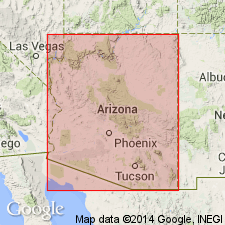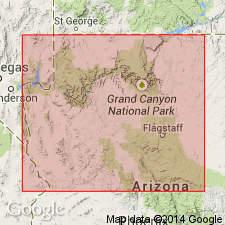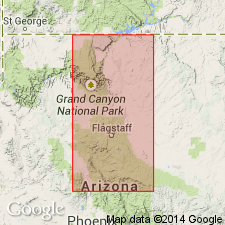
- Usage in publication:
-
- Buck and Doe Conglomerate
- Modifications:
-
- Original reference
- Dominant lithology:
-
- Conglomerate
- AAPG geologic province:
-
- Plateau sedimentary province
Summary:
Pg. 39-42. Buck and Doe Conglomerate. Predominantly white, and consists of angular to subrounded limestone and chert fragments; matrix is calcite. Some limestone pebbles contain Paleozoic fossils, presumed to be locally derived. Sediments show cross stratification toward southwest. Unit probably represents floodplain deposit. Rests unconformably on upper member of Hindu Canyon Formation (new) along the south side of Hindu Canyon and blankets the Hualapai Plateau to the south. On eastern edge of Hualapai Plateau and on Coconino Plateau, Robbers Roost gravels of Koons (1948) resemble the Buck and Doe and may be lithologic equivalent. In Milkweed Canyon, 1 of 2 gravels closely resembles the Buck and Doe. Age is Tertiary to Quaternary.
Type section: in Hindu Canyon, in secs. 20 through 25, T. 27 N., R. 12 W., Gila River and Salt River Principal Meridian, Mohave Co., northwestern AZ. [According to GNU records (USGS DDS-6; Denver GNULEX, Nov. 17, 1994), apparently named from "Buck and Doe Road" (fig. 1) on the Hualapai Plateau, Grand Canyon area, Mohave Co., AZ.]
Source: US geologic names lexicon (USGS Bull. 1350, p. 97); supplemental information from GNU records (USGS DDS-6; Denver GNULEX).

- Usage in publication:
-
- Buck and Doe Conglomerate
- Modifications:
-
- Revised
- AAPG geologic province:
-
- Plateau sedimentary province
Summary:
Diagrammatic cross section of Peach Springs Canyon shows Buck and Doe Conglomerate divided into (ascending); Milkweed Member and Peach Springs Member (both new). Milkweed Member overlies Westwater Formation (new) and Hindu Fanglomerate (new). Peach Springs Member underlies Hualapai Volcanics.
Source: GNU records (USGS DDS-6; Menlo GNULEX).

- Usage in publication:
-
- Buck and Doe Conglomerate
- Modifications:
-
- Overview
- Dominant lithology:
-
- Conglomerate
- AAPG geologic province:
-
- Plateau sedimentary province
Summary:
Consists of well cemented cliff-forming conglomerate of various Paleozoic pebbles. Type section stated to be in Hindu Canyon located on east side of Hualapai Plateau in western Grand Canyon, Mohave Co, AZ, Plateau sedimentary province. [Type designated by Gray, 1964, Ariz. Acad. Sci. Jour.] Overlies Westwater Formation (first used) with gradational contact; underlies Hualapai Volcanics (first used). Correlation chart. Assigned Miocene age.
Source: GNU records (USGS DDS-6; Denver GNULEX).
For more information, please contact Nancy Stamm, Geologic Names Committee Secretary.
Asterisk (*) indicates published by U.S. Geological Survey authors.
"No current usage" (†) implies that a name has been abandoned or has fallen into disuse. Former usage and, if known, replacement name given in parentheses ( ).
Slash (/) indicates name conflicts with nomenclatural guidelines (CSN, 1933; ACSN, 1961, 1970; NACSN, 1983, 2005, 2021). May be explained within brackets ([ ]).

